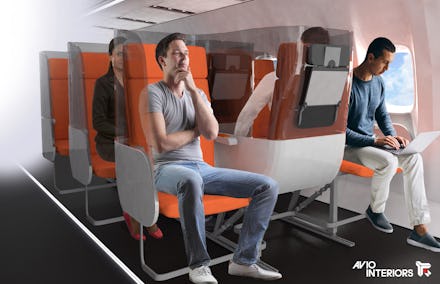Are socially distant seats the future of air travel?

Unsurprisingly, airlines have been among the hardest hit companies during the coronavirus pandemic. Planes are flying germ boxes, small inclosed spaces seemingly designed to spread infection and disease. To top it off, the recent drive toward cheaper flights has left passengers with ever-shrinking leg and elbow room, meaning we're smooshed in even closer, basically cheek-to-cheek with our neighbor and breathing in recycled air — the perfect environment for spreading a highly contagious virus like Covid-19.
The situation is making airlines rethink how they arrange their passengers to protect against the spread of illnesses. One company with a potential solution is Avio Interiors, an airline interior manufacturer that is proposing a new seat designed for traveling through a post-coronavirus world.
Avio has unveiled two types of seats for airlines to consider. The first concept is called 'Janus.' Named after an ancient Roman god with two faces that look away from each other, this concept focuses on seats that face in opposite directions. The model also includes a barrier between each seat to prevent "breath propagation to occupants of adjacent seats," according to the company.
"[T]his arrangement allows all three passengers to be separated with a shield made of transparent material that isolates them from each other, creating a protective barrier for everyone," Avio Interiors explains on its website. "Each passenger has its own space isolated from others, even from people who walk through the aisle."
The barrier can also come in varying levels of transparency, which could help with any awkward eye contact.
The second type of seat, called 'Glassafe,' is simply a barrier that can be installed on existing seats to shield passengers and flight attendants from each other. Although the seats are still arranged facing the same way with little space between each traveler, the company believes the design of the barriers can create "an isolated [area] around the passenger in order to avoid or minimize contacts and interactions via air" to reduce the risk of spreading infections.
The seats are currently undergoing approval from regulators, so passengers aren't likely to see something like this for a long while yet, according to Forbes. The barriers have to be safe enough to not cause additional harm to a traveler's head in the event of an accident, and they could also become an obstacle during an emergency evacuation or when passengers need to reach for oxygen.
Although these potential solutions are still in the idea stage, it's an interesting look at how industries will have to adapt and provide new levels of public safety in a post-pandemic world.